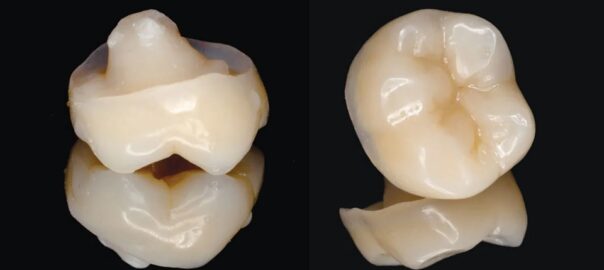Author: Dr. Aparna Singhal, MDS Gold Medalist, Prosthodontist
Abstract:
This article explores the transformative potential of endocrowns as a posterior restorative material following root canal treatment. Based on my clinical experience spanning over a decade, I present a philosophy that challenges traditional crown techniques like PFM and zirconia, emphasizing the success of endocrowns, especially in cases with limited interocclusal space and mutilated teeth. Case reports illustrate how extending the endocrown into pulp canals eliminates the need for posts and cores, leveraging the bulk and strength of lithium disilicate to achieve remarkable outcomes.
Introduction:
The restoration of endodontically treated teeth has long relied on traditional crowns, which often involve extensive tooth preparation and additional procedures such as post and core placement. These methods, while widely practiced, are invasive, time-consuming, and prone to biomechanical failures over time.
Endocrowns represent a revolutionary approach that prioritizes simplicity, strength, and conservation. My philosophy, honed through years of clinical practice, advocates for the routine use of endocrowns as a standard solution for post-endodontic restorations.
What is an Endocrown?
An endocrown is a monolithic restoration fabricated from materials like lithium disilicate. It is bonded adhesively to the tooth and extends into the pulp chamber and, in some cases, into the pulp canals. This design negates the need for posts and cores, making the procedure minimally invasive and biomechanically superior.
Why Endocrowns Should Be the Standard Choice:
1. Minimally Invasive: Unlike PFM and zirconia crowns, which require circumferential cutting, endocrowns preserve the tooth structure, reducing the risk of weakening the tooth.
2. No Need for Posts or Cores: By extending into the pulp canals, endocrowns provide excellent retention and stability without the need for additional post-and-core systems, simplifying the procedure.
3. Exceptional Strength: The bulk of lithium disilicate ensures unparalleled durability, even under heavy occlusal loads.
4. Time and Cost Efficiency: Endocrowns can be completed in just two appointments, making them a time-saving and cost-effective option for both patients and dentists.
5. Long-Term Success: My decade-long experience confirms that endocrowns rarely debond or fracture, making them a reliable choice for posterior restorations.
Case Reports:
Case 1: A 45-Year-Old Patient with Limited Interocclusal Space
Background: The patient presented with a severely worn mandibular molar following root canal treatment. Limited interocclusal space ruled out traditional crown placement.
Procedure: After minimal preparation, an endocrown was fabricated from lithium disilicate and bonded adhesively.
Outcome: Over three years of follow-up, the restoration showed excellent stability, aesthetics, and function, with no signs of debonding or wear.
Case 2: Restoration of a Mutilated Maxillary Molar
Background: A 50-year-old patient presented with a maxillary molar with extensive structural loss post-RCT.
Procedure: The endocrown was designed to extend into the pulp chamber, providing additional retention without the need for a post.
Outcome: The patient reported high satisfaction with the aesthetics and function, and the restoration remained intact during five years of follow-up.
Case 3: A Quick and Effective Solution for a Young Patient
Background: A 28-year-old patient required restoration of a mandibular second molar. The patient sought a cost-effective and time-efficient solution.
Procedure: The entire treatment was completed in two appointments: one for preparation and impression, and another for bonding the endocrown.
Outcome: The endocrown proved to be an ideal choice, providing durability and aesthetics while meeting the patient’s time and budget constraints.
Why Every Dentist Should Embrace Endocrowns:
Endocrowns are not just an alternative but a superior solution that every dentist should adopt for posterior restorations. The simplicity of the procedure, combined with the exceptional clinical outcomes, makes them a practical choice for routine practice.
Ease of Implementation: The technique requires no advanced equipment or training, making it accessible to all practitioners.
Reliability: The monolithic design of lithium disilicate ensures that the crown does not fracture or debond, even in challenging cases.
Cost-Effectiveness: The procedure is less expensive than traditional crowns, as it eliminates the need for posts, cores, and multiple appointments.
A Paradigm Shift in Restorative Dentistry:
Traditional crowns, like PFM and zirconia, demand significant tooth reduction and involve additional procedures that increase complexity and cost. Endocrowns, on the other hand, redefine the restorative approach by offering a minimally invasive, efficient, and durable solution.
Conclusion:
Endocrowns represent a paradigm shift in post-endodontic restorations. My decade-long clinical journey demonstrates their unparalleled success, even in the most challenging cases. They are a testament to the evolving philosophy of dentistry—one that prioritizes patient comfort, conservation of tooth structure, and long-term outcomes.
Call to Action:
As dental professionals, we must question traditional practices and embrace innovations that improve patient care. Endocrowns are a game-changer, and it is time for every practitioner to incorporate them into routine practice. By doing so, we can transform the way we restore endodontically treated teeth, delivering superior results with greater ease and efficiency.




